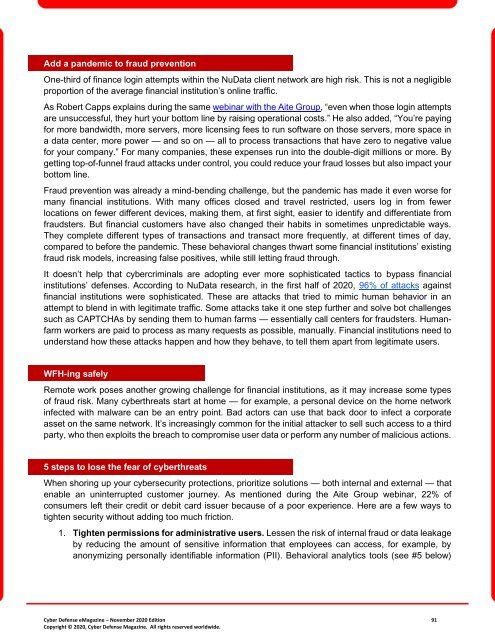Cyber Defense eMagazine November 2020 Edition
Cyber Defense eMagazine November Edition for 2020 #CDM #CYBERDEFENSEMAG @CyberDefenseMag by @Miliefsky a world-renowned cyber security expert and the Publisher of Cyber Defense Magazine as part of the Cyber Defense Media Group as well as Yan Ross, US Editor-in-Chief, Pieruligi Paganini, Co-founder & International Editor-in-Chief, Stevin Miliefsky, President and many more writers, partners and supporters who make this an awesome publication! Thank you all and to our readers! OSINT ROCKS! #CDM #CDMG #OSINT #CYBERSECURITY #INFOSEC #BEST #PRACTICES #TIPS #TECHNIQUES
Cyber Defense eMagazine November Edition for 2020 #CDM #CYBERDEFENSEMAG @CyberDefenseMag by @Miliefsky a world-renowned cyber security expert and the Publisher of Cyber Defense Magazine as part of the Cyber Defense Media Group as well as Yan Ross, US Editor-in-Chief, Pieruligi Paganini, Co-founder & International Editor-in-Chief, Stevin Miliefsky, President and many more writers, partners and supporters who make this an awesome publication! Thank you all and to our readers! OSINT ROCKS! #CDM #CDMG #OSINT #CYBERSECURITY #INFOSEC #BEST #PRACTICES #TIPS #TECHNIQUES
Create successful ePaper yourself
Turn your PDF publications into a flip-book with our unique Google optimized e-Paper software.
Add a pandemic to fraud prevention<br />
One-third of finance login attempts within the NuData client network are high risk. This is not a negligible<br />
proportion of the average financial institution’s online traffic.<br />
As Robert Capps explains during the same webinar with the Aite Group, “even when those login attempts<br />
are unsuccessful, they hurt your bottom line by raising operational costs.” He also added, “You’re paying<br />
for more bandwidth, more servers, more licensing fees to run software on those servers, more space in<br />
a data center, more power — and so on — all to process transactions that have zero to negative value<br />
for your company.” For many companies, these expenses run into the double-digit millions or more. By<br />
getting top-of-funnel fraud attacks under control, you could reduce your fraud losses but also impact your<br />
bottom line.<br />
Fraud prevention was already a mind-bending challenge, but the pandemic has made it even worse for<br />
many financial institutions. With many offices closed and travel restricted, users log in from fewer<br />
locations on fewer different devices, making them, at first sight, easier to identify and differentiate from<br />
fraudsters. But financial customers have also changed their habits in sometimes unpredictable ways.<br />
They complete different types of transactions and transact more frequently, at different times of day,<br />
compared to before the pandemic. These behavioral changes thwart some financial institutions’ existing<br />
fraud risk models, increasing false positives, while still letting fraud through.<br />
It doesn’t help that cybercriminals are adopting ever more sophisticated tactics to bypass financial<br />
institutions’ defenses. According to NuData research, in the first half of <strong>2020</strong>, 96% of attacks against<br />
financial institutions were sophisticated. These are attacks that tried to mimic human behavior in an<br />
attempt to blend in with legitimate traffic. Some attacks take it one step further and solve bot challenges<br />
such as CAPTCHAs by sending them to human farms — essentially call centers for fraudsters. Humanfarm<br />
workers are paid to process as many requests as possible, manually. Financial institutions need to<br />
understand how these attacks happen and how they behave, to tell them apart from legitimate users.<br />
WFH-ing safely<br />
Remote work poses another growing challenge for financial institutions, as it may increase some types<br />
of fraud risk. Many cyberthreats start at home — for example, a personal device on the home network<br />
infected with malware can be an entry point. Bad actors can use that back door to infect a corporate<br />
asset on the same network. It’s increasingly common for the initial attacker to sell such access to a third<br />
party, who then exploits the breach to compromise user data or perform any number of malicious actions.<br />
5 steps to lose the fear of cyberthreats<br />
When shoring up your cybersecurity protections, prioritize solutions — both internal and external — that<br />
enable an uninterrupted customer journey. As mentioned during the Aite Group webinar, 22% of<br />
consumers left their credit or debit card issuer because of a poor experience. Here are a few ways to<br />
tighten security without adding too much friction.<br />
1. Tighten permissions for administrative users. Lessen the risk of internal fraud or data leakage<br />
by reducing the amount of sensitive information that employees can access, for example, by<br />
anonymizing personally identifiable information (PII). Behavioral analytics tools (see #5 below)<br />
<strong>Cyber</strong> <strong>Defense</strong> <strong>eMagazine</strong> – <strong>November</strong> <strong>2020</strong> <strong>Edition</strong> 91<br />
Copyright © <strong>2020</strong>, <strong>Cyber</strong> <strong>Defense</strong> Magazine. All rights reserved worldwide.


















